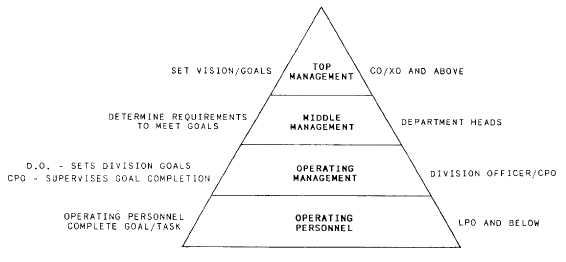CHAPTER 3
LEADERSHIP
LEARNING OBJECTIVES
Upon completion of this chapter, you should
1. Describe how to apply sound leadership
4.
practices to managerial abilities.
2. Interpret command or departmental instruc-
tions and documents used to formulate
5.
division work requirements.
3. Analyze division material and personnel
6.
readiness.
be able to do the following:
Identify the steps necessary to monitor the
progress of overall division work efforts.
Identify the methods used to determine
division timelines.
Identify the methods used to monitor the
assignment of division personnel.
This chapter addresses the topics of leadership
and management. The chapter should provide you
with an introduction to the fundamentals of
leadership and management required at the chief
petty officer level. Topics covered in this chapter
include effective management, leadership, personal
characteristics, and Total Quality Management
(TQM). An in-depth discussion of the topics
presented in this chapter is beyond the scope of
this text. However, Management Fundamentals:
A Guide for Senior and Master Chief Petty
Officers, NAVEDTRA 10049, gives an excellent
general overview of leadership and management
fundamentals used by chief petty officers.
SUPERVISORY RESPONSIBILITIES
Within the formal Navy management structure,
management begins at the chief petty officer level
(fig. 3-1). Top-level management is composed of
Figure 3-1.-Levels of management.
3-1


